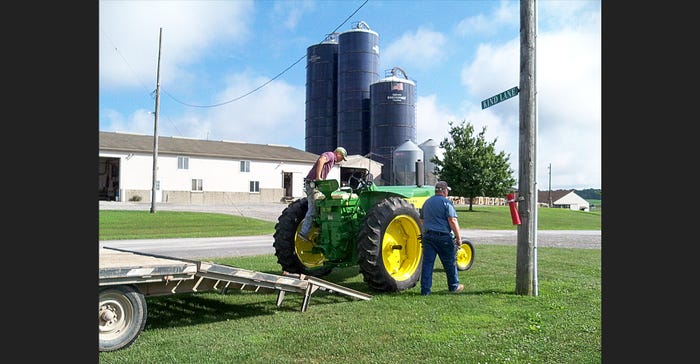August 31, 2018

CLASSIC POWER: Dean and Dwight Kind prepare to load a tractor to show at the local fair.Carol Ann Gregg
By Carol Ann Gregg
Dean Kind credits attending a meeting prior to the high point in milk prices for helping him weather the current downturn in milk.
"We heard David Kohl, who talked about the cyclical nature of the dairy industry," says Dean, who is a partner with his brother Dwight at Grassycrest Dairy Farm. "He said to build a safeguard and to brace yourself for the downtimes coming. We took that to heart."
In 2014, when milk prices were at their highest, the Kinds paid down debt. They were careful with their equipment purchases and prepared for the downturn.
"We didn't expect it to last this long but I am so glad we were prepared," he says. "My brother and I are very different. He likes to be on the tractor and I like the cows. I think that is a good thing. But one thing we agree on, we don't like debt."
The herd of Holsteins and Jerseys numbers 330 head.
"We don't cut back on feed, but we aren't pushing them too hard," he says. "At one time we were up to 425 cows, milking three times a day. We reduced the size of the herd and went to milking twice a day."
The few Jerseys in the herd stand out.
"We got Jerseys when my son Logan wanted to show Jerseys," he says. "We have some crossbred but those have been bred back to Jersey bulls, so we have some that are fifth-generation Jersey. There are about 30 Jerseys now."
The Jerseys help to increase the milk components, which Kind says is a benefit. The herd averages 4.2% butterfat and 22,000 pounds per cow. The somatic cell count is about 145,000.
Conservation since day one
Richard and Blanche Kind established Grassycrest in 1970. They were known for their dedication to the industry and have always incorporated sound conservation practices.
This year, a new riparian area was established with over 700 trees planted. This conservation area is between the main farm and the construction site for a new heifer facility.
"We are watching methane digesters," he says. "They are getting better and more economical. That seems to be the future. We want to be prepared."
The manure pit of the milking barn is connected to the manure pit at the current heifer barn. The new heifer barn creates a triangle with the milking barn and the current heifer facility.
Over the years, Grassycrest has grown as small, adjoining farms have become available.
As Kind contemplates some of the things they are doing now to deal with low milk prices, his son, Lane, says they are looking to sell some extra baled hay this year. The two say they are culling more quickly than in the past.
"We are less likely to treat for mastitis and just send her to the auction," Dean says.
"This eliminates treatment costs, vet bills and it makes more room at the bunk for the other cows," Lane says.
"We have postponed equipment upgrades. We plan to ride it out," Dean says.
Antique tractor showings
Farmers need to find positive things to do during these tough economical times. The Kind brothers like to show their antique tractors at the county fair. These tractors have a sentimental value.
A John Deere "A" and a pickup truck that their maternal grandfather purchased new were severely damaged in a fire that destroyed their machinery shed and shop. Both vehicles were being restored at the time.
"The pickup truck was damaged beyond repair, but we were able to completely restore the tractor," Dean says.
The "A" and their John Deere 730 were displayed with the antique tractors at the recent Lawrence County Fair.
"I was hoping that a buddy and I could drive the tractors over to the fair," Lane says. "We never used tractors like these in the fields."
But the tractors were loaded and hauled to the fair on a trailer.
Dean also credits living in an area with great neighbors.
"We have neighbors who help during harvest," he says. "We live in a great neighborhood. There are retired truck drivers who come and help out. There are a couple of guys who like to drive tractor to pack down the bunk. It is great, and it really helps."
Lane's own sons — Braidin, 9; Chase, 8; and Hayden, 6 — spend nearly every day on the farm.
"I love teaching them something new every day," Lane says, recalling the lessons learned from his father, grandfather and uncle when he was growing up.
Knowing that his son wants to farm, and that his three grandsons are growing up on the farm, Dean has a real motivation to work toward the future.
"This isn't a sprint, it is more like a marathon," he says. "Farming isn't just what you do but who you are."
You May Also Like




